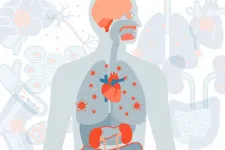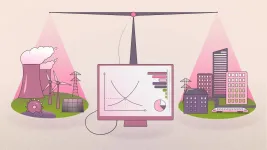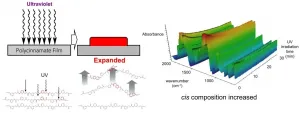(Press-News.org) Irvine, Calif., April 22, 2021 -- California's wildfire problem, fueled by a concurrence of climate change and a heightened risk of human-caused ignitions in once uninhabited areas, has been getting worse with each passing year of the 21st century.
Researchers in the Department of Civil & Environmental Engineering at the University of California, Irvine have conducted a thorough analysis of California Department of Forestry and Fire Protection wildfire statistics from 2000 to 2019, comparing them with data from 1920 to 1999. They learned that the annual burn season has lengthened in the past two decades and that the yearly peak has shifted from August to July. The team's findings are the subject of a study published today in the open-access journal Scientific Reports.
The study is a focused examination of fire frequency, burned area and myriad drivers of the catastrophically destructive events. The team found that the number of hot spots - places with severe fire risk - has grown significantly in recent years, fueled by higher annual mean temperatures, greater vapor pressure deficit (lack of air moisture), drought, and an elevated chance of blazes being sparked through such human causes as power line disruptions, construction, transportation, campfires, discarded cigarettes and fireworks.
"CALFIRE data show that each new year of the 21st century has been a record breaker in terms of wildfire damage in California," said co-author Tirtha Banerjee, UCI assistant professor of civil & environmental engineering. "We also have seen that about 80 percent of the total number of the state's wildfires over the past few decades have been small, measuring less that 500 acres. But when fires get large, their deadliness greatly increases."
Banerjee said that to gain a proper understanding of the growth of fire risk in California, it's important to put large and small incidents into separate buckets. By doing this, the team learned that 1,247 out of 6,336 wildfires, about 20 percent, accounted for 97 percent of the total burned area in the 2000 to 2020 period.
"And more than nine-tenths of the casualties and property losses can be attributed to fires exceeding the 500-acre threshold," Banerjee said.
He added that over the past two decades, there has been a significant increase in "extreme" wildfires scorching more that 10,000 acres. Coinciding with that has been a rapid uptick in the frequency of small, human-caused blazes.
One of the most alarming findings of the study, according to lead-author Shu Li, a Ph.D. student in Banerjee's laboratory, is the substantial spatial growth of fire risk throughout the state. From 1920 to 1999, California's only hot spot with "very high wildfire density" was Los Angeles County. In the past 20 years, that designation has expanded greatly in Southern California to include Ventura County, and portions of Riverside, San Diego and San Bernardino Counties.
Even in northern California, areas known by fire managers as the Nevada-Yuba-Placer Unit and the Tuolumne-Calaveras Unit are newly emerged as high-density wildfire regions.
"Before 2000, there were almost no human-caused wildfires along California's Pacific coastline, but now nearly every coastal county is experiencing increased risk, and the San Benito-Monterey Unit and the San Luis Obispo Unit have even become new hot spots," said Li.
Many of the major fires in the northern part of the state are naturally occurring, predominantly ignited by lightning. But the majority of the increase in fire probability in recent years can be blamed on an expansion of the wilderness-urban interface. As people move into previously unpopulated areas, they bring their bad fire management habits with them.
"The concurrence of human-caused climate change, which is drying out our forests and grasslands and creating longer stretches of hot weather, and a steady influx of people into remote areas is creating conditions for the perfect fire storm," said Banerjee. "But there is some good news in all of this; human-caused fire risk can be mitigated by better fire management practices by humans."
He said he hoped the study and the near real-time analysis of fire risks in California's natural environment it provides can be used by government agencies and public policy officials to both prevent and combat costly blazes.
INFORMATION:
Funding for this research project was provided by the Henry Samueli School of Engineering at UCI and the UC Office of the President.
About the University of California, Irvine: Founded in 1965, UCI is the youngest member of the prestigious Association of American Universities and is ranked among the nation's top 10 public universities by U.S. News & World Report. The campus has produced three Nobel laureates and is known for its academic achievement, premier research, innovation and anteater mascot. Led by Chancellor Howard Gillman, UCI has more than 36,000 students and offers 224 degree programs. It's located in one of the world's safest and most economically vibrant communities and is Orange County's second-largest employer, contributing $7 billion annually to the local economy and $8 billion statewide. For more on UCI, visit http://www.uci.edu.
Media access: Radio programs/stations may, for a fee, use an on-campus ISDN line to interview UCI faculty and experts, subject to availability and university approval. For more UCI news, visit news.uci.edu. Additional resources for journalists may be found at communications.uci.edu/for-journalists.
A minimally invasive retinal reattachment procedure that can be done in an ophthalmologist's office leads to better long-term integrity and structure of the retina's photoreceptors - cells that allow us to see - compared with more invasive operating room procedures, according to new research published April 22.
The study, published in JAMA Ophthalmology and led by researchers at St. Michael's Hospital of Unity Health Toronto, contributes to a growing body of evidence pointing towards pneumatic retinopexy (PnR) as the better first-line retinal reattachment technique to achieve the best visual outcomes.
Retinal detachment is the most common surgical ocular emergency, progressing to loss of vision within hours ...
Chestnut Hill, Mass. (4/22/2021) - Confirming anecdotal evidence that the spread of the coronavirus has strained Americans' mental health, Boston College researchers found reports of anxiety increased to 50 percent and depression to 44 percent by November, 2020 - rates six times higher than 2019 - according to a new report in the journal Translational Behavioral Medicine.
Among U.S. adults aged 18-29, the impact on mental health was even more severe. Rates of anxiety and depression increased to 65 percent and 61 percent, respectively, of the respondents in that age group, according to the report.
Use of prescription medication, counseling services, and unmet need for mental health services also rose significantly, according to the co-authors of the new study, Boston ...
As the COVID-19 pandemic has progressed, it has become clear that many survivors -- even those who had mild cases -- continue to manage a variety of health problems long after the initial infection should have resolved. In what is believed to be the largest comprehensive study of long COVID-19 to date, researchers at Washington University School of Medicine in St. Louis showed that COVID-19 survivors -- including those not sick enough to be hospitalized -- have an increased risk of death in the six months following diagnosis with the virus.
The researchers also have catalogued the numerous diseases associated ...
Skoltech scientists in collaboration with researchers from the University of Arizona and the Los Alamos National Laboratory have developed an approach that allows power grids to return to stability fast after demand response perturbation. Their research at the crossroads of demand response, smart grids, and power grid control was published in the journal Applied Energy.
Power grids are complex systems that manage the generation, transmission and distribution of electrical power to consumers, also called loads. As it is not possible to store electrical energy along the transmission lines, grid operators must ensure, ideally at all times, the balance between production and consumption of electrical energy, ...
A test which uses artificial intelligence (AI) to measure proteins present in some patients with advanced bowel cancer could hold the key to more targeted treatment, according to research published today.
A team at the University of Leeds collaborated with researchers at Roche Diagnostics to develop the technique, which will help doctors and patients to decide on the best treatment options.
They used samples from a previous trial funded by Cancer Research UK to look at the levels of two proteins, known as AREG and EREG, which are produced by some colorectal cancers.
Algorithms driven by AI enabled the researchers to show that patients with higher levels of these proteins received significant benefit from a treatment which inhibits a different protein involved ...
Key takeaways
Tourniquet use has been consistently increasing in Los Angeles County since 2015 and is significantly associated with improved patient survival.
Tourniquet use is safe and does not lead to increased risk of amputation with proper surgical care after arriving at the hospital.
Findings are specific to Los Angeles County, where patients who had a tourniquet placed were able to be transported quickly to a trauma center for further life-saving care.
CHICAGO (April 22, 2021): Uncontrolled bleeding continues to be one of the most common causes of preventable ...
Insect decline is one of the greatest challenges facing our society. As a result of the destruction of many natural habitats, bees, bumblebees, butterflies, beetles and the like find less and less food. As a consequence, they are barely able to fulfil their role as pollinators of wild and cultivated plants. This trend is increasingly noticeable in agricultural regions in particular.
Researchers at the University of Münster have now taken a more detailed look at how the choice of seeds in restoration measures - i.e. the restoration of natural habitats at degraded land - affects how insects benefit from these measures. Here, not only the plant ...
A phenomenon of "photoexpansion" in hard plastic films with a high glass transition temperature in the dry state was established, which was essentially different from very soft actuators, such as elastomers or gels. The photoexpanding hard actuators were expected to apply in the wide fields because they do not contain vaporable matters such as solvents and were much more thermoresistant than conventional ones.
Ishikawa, April 22, 2021 - Polymers that exhibit their functions by light have been studied for a few decades because they enable device miniaturization, energy saving, and precise signal control. Polymers based on azobenzene, diarylethene, etc. are the pioneers, ...
Patients with chronic kidney dysfunction frequently develop thickening of the heart muscle, so-called left ventricular hypertrophy. This is particularly pronounced in patients who are in the late stage of renal dysfunction, that is to say those requiring renal replacement therapy such as haemodialysis. The danger of this cardiac hypertrophy lies in the considerable associated increase in risk of acute cardiovascular disease, such as sudden cardiac death, for example. Haemodialysis patients have a number of risk factors for developing this form of cardiac hypertrophy. One of those is elevated levels of the protein Fibroblast Growth Factor 23 (FGF23), ...
- Recent discoveries focused on manipulation of atomically-thin 2D materials, while the new breakthrough can be used to stack technologically-relevant 3D materials at a twist angle
- Method allows continuous, systematic control of optical emission intensity and energy, and can produce ultraviolet emissions at room temperature for bulk systems
- The discovery can be significant for applications in medicine, environmental or information technologies.
Singapore, 22 April 2021 - Researchers from the Low Energy Electronic Systems (LEES) Interdisciplinary Research ...





